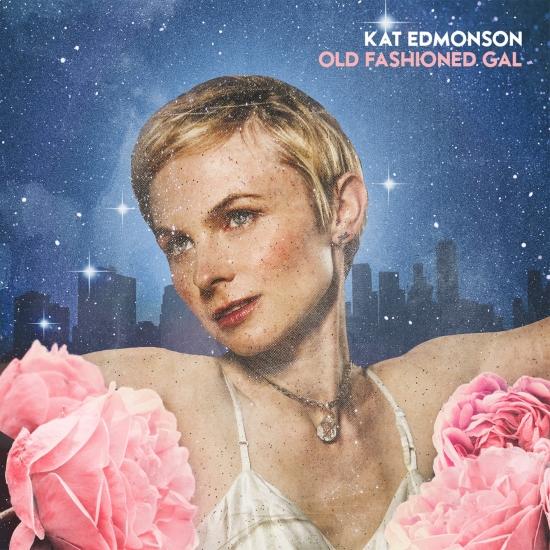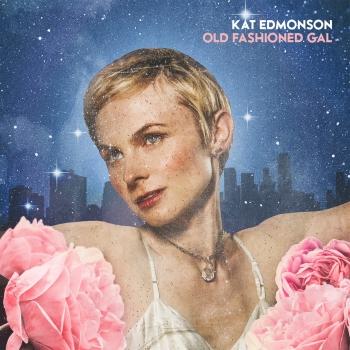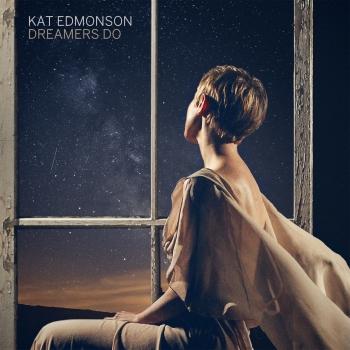
Old Fashioned Gal Kat Edmonson
Album info
Album-Release:
2018
HRA-Release:
08.01.2019
Album including Album cover
- 1Sparkle and Shine03:27
- 2I'd Be a Fool02:51
- 3A Voice04:25
- 4If03:08
- 5Canoe03:00
- 6Old Fashioned Gal03:01
- 7Please Consider Me04:44
- 8How's About It Baby03:11
- 9Goodbye Bruce02:31
- 10With You03:33
- 11Not My Time03:09
Info for Old Fashioned Gal
Singer-songwriter Kat Edmonson is back with Old Fashioned Gal, an album that really couldn’t be called anything else.
Rich in affection for the past but bracingly alive in the present, the 11 original songs on Old Fashioned Gal tell a story––actually, a classic Hollywood “movie” that took shape in Edmonson’s imagination as she began to write them. These songs have all the feeling and the craft, even the entertaining bounce, of the Great American Songbook, from Irving Berlin to Joni Mitchell but they are unmistakably Kat Edmonson’s songs, taking the full measure of her own voice, literally and figuratively. The inimitable voice in which she sings is a musical prism, crystalline and precise, refracting and transforming what shines through it. The voice in which she writes is clear, intensely aware and to the point––an “old fashioned gal” in the here and now.
Edmonson describes her process, “The main ingredients I used to make this record were piano, bass, guitar, and drums; however, there is a 13-piece string orchestra on the album as well as background vocals, horns, woodwind instruments, vibes and other percussion, organ, celesta, harp, ukulele…even a saw! I was trying to achieve the lushness of an MGM musical. In “Canoe,” my lyrics talk about mosquitos and katydids around a lake so, for that song, I went outside one evening and recorded the ambient sounds of insects and frogs. THAT was really fun!”
In little more than a decade, Kat Edmonson has emerged as one of the most distinctive performers in contemporary American music. The Texas native forged her sound performing in small rooms and clubs, then touring worldwide and performing with the likes of Lyle Lovett, Chris Isaak, Jamie Cullum and Gary Clark Jr. Her three previous albums revealed a singer discovering, in her own songs, a repertoire only she could imagine. A critic for the Boston Globe called Way Down Low, her second album, “one of the greatest vocal albums I’ve ever heard.” Her third, The Big Picture, took greater advantage of her songwriting abilities. The Austin Chronicle’s critic noted she “employs lessons gleaned from the Great American Songbook while creating an aura unmistakably her own,” adding that the songs emerge “fresh and dewy … Edmonson’s voice swells and dips and weaves with effortless precision, arresting without belting.”
The “movie” that drives Old Fashioned Gal took shape while Kat Edmonson––at a pivotal point in her young career––was fighting a bitter cold in a Brooklyn apartment during the winter of 2016.
“I was sick in bed for days watching old films on Turner Classic Movies and, eventually, I got inspired and began to write,” she says. “I would watch one movie and then stop to work on a song and then turn on another movie … I wrote the majority of the album this way. At some point in this process, I started imagining scenes for a film that corresponded with my music and I envisioned my songs being sung by these certain characters––a young man who was a songwriter, a young woman who was a singer, and an older gentleman who was a Broadway producer––
and I ended up writing an entire outline for a musical.”
Edmonson describes the heroine of her story as “a young woman in showbiz struggling with her personal definition of success and what it means to be an artist.” The story has a romantic sub-plot involving the songwriter as well as a helper-type character, the elderly Broadway producer, named Bruce. The all-knowing producer is Edmonson’s tribute to the late Bruce Lundvall, a legendary record executive with a fabled ear for the next big thing and a mentor to Edmonson in his last years. She pays affectionate tribute to Lundvall on the new album’s wistful track “Goodbye Bruce.”
Another figure dances around the aura of Old Fashioned Gal––Fred Astaire. Astaire is not a presence in the album’s story, but everything about him has loomed large in Edmonson’s imagination since, as a little girl, she first saw his movies on TV. For a time in those years, she and her mother lived in Los Angeles and attended the same church to which Astaire belonged. Sometimes, Edmonson recalls with relish, “he would wave to me from the back pew.”
“Sparkle and Shine,” which opens Old Fashioned Gal, began for her as a bit of self-motivation in a tough moment. She imagined Astaire singing it, embodying it. “Even though he never considered himself a singer,” she says, “in my book, he was one of the best because he conveyed all the sentiments of a song.” Deeper into the album, “With You” was inspired by the deep longing and the sublime grace of Astaire’s performance of “One for My Baby” in the musical The Sky’s the Limit.
Elsewhere, Edmonson’s inspiration recalls the vocal trio The Fleetwoods (in “I’d Be a Fool”) and even The Ink Spots (in “If”). There’s a flash of New Orleans jazz in “With You,” and the tang of a Hammond B3 organ in “Canoe,” in which Edmonson remembers her live-wire godmother, who liked to dance and to play “Alley Cat” on the organ. “Please Consider Me” came into being as she endured a hellish working trip to Paris that ended in 24 grueling hours at Charles de Gaulle Airport. “The music was in my head,” she says, adding with a laugh, “and I ended up writing this beautiful tribute to Paris – as everyone always does.”
The title song on Old Fashioned Gal is shot through with fresh irony, at first a clever protest against the conformity it takes to be “liked” in the Facebook era but, on a deeper level, a longing for the elusive personal connection in these very fast-moving times. Edmonson says that the voice and the drop-dead wit of the great American singer/songwriter Blossom Dearie were in her head as she wrote “Old Fashioned Gal.” Nostalgia, however, is the farthest thing from Kat Edmonson’s mind and restless imagination.
“I feel very fortunate to be living in these progressive times. Many, many circumstances have changed for the better now. I’m not under an illusion that old days were better days nor am I caught up in the novelty of old things but I do love the romance of a lot of old things… the time and care that people took to make them… the attention to detail and the appreciation of nuance. These are the things that last. This is what inspires me.”
Edmonson produced Old Fashioned Gal with that very attention to detail and appreciation of nuance, but also with that love of the romance in those old things. When she talks about the songs she wrote and realized for the album, she makes it clear that the vintage influences are a means to getting her closer to what she wants to express––nothing less than “the importance of following your heart and your dreams and being true to yourself no matter what.” In the album’s final track––“Not My Time”–– she embraces who she is, here and now.
“This is me, take it or leave it, a humble sentiment,” Edmonson says of the wry but determined song. “Things I anticipated would happen, that haven’t––it’s a funny sort of comment on that. It’s a happy ending, albeit a realistic one.”
Getting to this particular happy ending has been its own hard-won reward for Kat Edmonson, a realization that drives perhaps the most personal song on Old Fashioned Gal––“A Voice.” It was not intended for the album; for a time, in fact, she was reluctant even to sing it. But “A Voice” answered a moment of self-doubt, when other forces in her life and career had led her to wonder about the value of that most essential, literal-and-figurative Kat Edmonson quality––her voice. It is a bolder statement than it may seem at first. This is an artist finding herself, knowing at last what she wants, understanding how the whole of her art can be greater than the sum of its parts.
“I wrote it because I needed to,” Edmonson says of the healing, transformative song. “I’ve been generally self-assured in my life, but I recently found myself feeling very self-conscious, full of doubts. I was quite literally saying ‘If I had a voice …,’ because I felt I didn’t have one anymore. This song is about why I matter: because I’m me. I can’t be anybody else.” by David Foil
 Kat Edmonson
Kat Edmonson
aged 26, has one album to her name, and it’s been out for just a few months. She has had no formal training, no big-shot mentor. Instead she has a preternaturally gifted voice, sense of rhythm, and ability to swing. Where other singers her age tend to belt out a tune, she retreats, nearly whispering the lyrics, with a timbre that recalls Blossom Dearie. Comparing Edmonson to Norah Jones and Madeleine Peyroux doesn’t quite work; she’s more jazz-focused than they are, even if her set list is more contemporary than theirs. With an imaginative repertoire that includes jazzy remakes of the Cure’s “Just Like Heaven’’ and the Cardigans’ “Lovefool’’ and updates of such classics as “Angel Eyes’’ and “Just One of Those Things,’’ Edmonson might be the most promising American jazz singer to come along since Cassandra Wilson.
“Jazz is progressive, and it’s alive,’’ she says. “I wanted to make it fresh. I wanted to make it sound like I was recording this music in 2009 and still remain timeless somehow.’’
In an interview from her home in Austin, Texas, Edmonson talks matter-of-factly about her life and career. Her nature is unassuming and modest. She sounds as though she feels genuinely blessed to be singing for a living rather than working at a Starbucks or for a real estate broker, both of which she was doing a few years ago.
Music came to her through osmosis. There were no lessons. Growing up in Houston, she got acquainted with the American songbook through the old records her mother played on the stereo and the old movies she popped into the VCR: musicals with Fred Astaire, Gene Kelly, Danny Kaye, and Bing Crosby. By the time she was 9, she was writing songs.
By high school she was consuming music obsessively, but it wasn’t a career path. After graduation, she moved to South Carolina and enrolled at the College of Charleston, intending to study interior design and furniture design. Still, music beckoned, and she started singing - pop songs, her own compositions - at a blues club there. But the hectic schedule of studying full time, working full time at a coffee shop, and singing at night was taxing. And tuition was growing expensive.
She turned her attention back to Texas, this time to Austin and its thriving music scene. She enrolled in a community college, planning to study during the day and sing at night. “When I was driving home after registration, I heard this song on the radio, a guy singing about not ever going to class in college and always hanging out and singing for his friends,’’ she says. “I laughed and said, I can relate, because it was so much like me. I realized right then I would pull out of school and pursue a music career.’’ She withdrew from college and began looking for work with local bands.
In 2002 she auditioned for “American Idol’’ and wound up in the group of 48 invited to Hollywood, but she was quickly dismissed (“You just don’t look like a star, dog,’’ Randy Jackson told her). She returned to Austin and had a series of jobs: waitress, telemarketer, nanny. She sang at open-mike nights. In June 2005 she found herself at a Monday night jazz jam at an Austin club called the Elephant Room. It was there that she realized jazz was her calling.
Mike Mordecai, a trombonist who’s been running the jazz jam since 1980, remembers the first time Edmonson came in - and recalls pegging her wrong. He assumed she was just another “chick singer,’’ as he puts it. “I’m kind of rolling my eyes,’’ he says. “She was young and cute. We’re like, OK, what do you want to sing? She had a nice voice. She started coming in every week. A few weeks into it, it started becoming apparent that she had something special.’’
The door to a music career was opening, but it wasn’t wide enough. Edmonson needed to find more gigs, so she quit her waitressing job and found 9-to-5 hours with a real estate broker. Soon that became problematic too. “My enthusiasm for the job began waning almost immediately, because I was staying up really late at night to sing,’’ she says. “My boss called me into his office one day; he said I wasn’t the energetic girl he hired. At that moment I realized there was no time to waste.’’ She told her boss he was right, and she quit.
Edmonson has spent the past three to four years singing full-time, mostly in Texas but occasionally elsewhere. She played a few dates in the Northeast in the spring and comes back this way next Sunday for her Tanglewood debut.
The invitation to play Tanglewood came after Dawn Singh, who programs the Tanglewood Jazz Festival, heard her CD, “Take to the Sky,’’ and was struck by her restrained style.
“There’s something about her voice that’s really soothing,’’ Singh says. “There’s also something about her personality, her down-to-earth attitude, that I really like.’’
Edmonson seems to take it all in stride, happy to be doing what she loves, flattered that someone might like her singing. There isn’t a trace of entitlement in her words. She credits her pianist and arranger, Kevin Lovejoy, for making her interpretations of standards and pop songs sound so fresh. She talks about her goals in broad terms, with wide-eyed optimism.
“I want to tour, everywhere I can, all of the world,’’ she says. “I want to play more festivals. I already have ideas for another record. I want to do this for the rest of my life.’’
-Steve Greenlee, The Boston Globe
This album contains no booklet.














